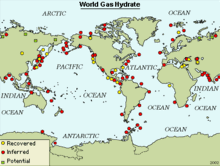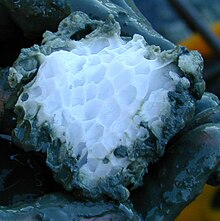Gas hydrate
Gas hydrates are inclusion compounds in the solid aggregate state that consist of a gas - such as the noble gases ( argon , krypton , xenon ), chlorine , bromine , aromatic hydrocarbons or alkanes - and water. Natural gas hydrates mainly contain gases such as methane , carbon dioxide and hydrogen sulfide . Forms that mainly contain a certain gas molecule, such as methane, are known as methane hydrate , for example .
history
Gas hydrates were first found in 1811 by Humphry Davy in the form of chlorohydrate. They were considered curios for a long time, until around 1930 it was discovered that an ice-like substance was clogging natural gas pipelines in cold regions. In 1965, the Soviet petroleum engineer Yuri Makogon discovered the existence of naturally occurring gas hydrates in sediments below a natural gas deposit in Siberia.
These substances were methane hydrate, which had formed with the water in the natural gas under the pressure of the pipeline. This problem with the transport of natural gas is circumvented by transporting certain chemicals, inhibitors , with it. They change the conditions necessary for the formation of gas hydrates in such a way that as few gas hydrates as possible arise at the temperatures and pressures prevailing in the pipeline. Nevertheless, more and more gas hydrates can form or accumulate, especially on valves and instruments.
Origin and occurrence
The most important factors that lead to the formation of natural gas hydrates are pressure , temperature and a high gas concentration in the surrounding environment (free gas dissolved in the sediment or in the pore water). At high pressure, low temperature and a correspondingly high gas concentration, the gas molecules in the sediment or on the sea floor are “trapped” in a molecular lattice consisting of water molecules during clathrate formation . This creates a cage made up of several water molecules in which a gas molecule is enclosed. One cubic meter of gas hydrate contains around 164 m³ of the corresponding gas.
The formation of clathrates fills the pore space of the sediment and deposits arise as a sediment-gas hydrate mixture. The sediment is cemented and solidified by gas hydrate, which is of great importance for the stability of continental slopes. The gas hydrate is lighter than water and is held in this way by the heavier sediment on the sea floor. Free gas hydrate in the water column rises quickly to the top. On its way it decomposes and transports the corresponding released gas (possibly a greenhouse gas ) into the water column and possibly directly into the atmosphere . In the sediment, the gas hydrate is stable up to a depth of a few hundred meters. Among other things, due to sedimentation processes over long time scales, the gas hydrates formed near the sediment surface can be located at greater depths below a stable cover layer. At greater sediment depths, the gas hydrate becomes unstable again due to the heat flow from the earth.
application
During CO 2 sequestration, the process of gas hydrate formation is intended to ensure that CO 2 from power plants is safely deposited on the sea floor for a long time, for example, and thus cannot get into the atmosphere. Under favorable conditions, the CO 2 artificially introduced into deep sediment layers can be converted into the solid hydrate structure there and thus stored in a stable manner.
Recent seismic studies suggest that the amount of methane hydrate deposits on the ocean floor is very important. They could therefore be a possible important source of energy , even if the loss-free degradation could prove to be quite difficult, since methane as a greenhouse gas must not enter the atmosphere in large quantities. The total amount of greenhouse gases from fossil fuels should be less than the amount of greenhouse gases that could be released from the gas hydrate deposits. Both carbon dioxide and methane are greenhouse gases. Estimates range from a total of more than 1,000 Giga of tons of carbon that is stored in the various types of gas hydrates.
But the gas hydrates are not only of interest as a source of energy. They also ensure the stability of the seabed in certain places. Sudden temperature or pressure differences and the associated destruction or destabilization of the gas hydrate layer can cause the sea floor to slide off the continental slopes ( Storegga ), which could result in a tsunami .
Gas hydrates could simplify the transport of natural gas on ships. A storage temperature of –10 ° C would only be required for transport, in contrast to the storage temperature for liquefied natural gas of –162 ° C.
With regard to global warming , gas hydrate must be viewed from three angles:
- Its use is controversial not only because of possible accidents during mining, but above all because of the fact that it is another fossil fuel that would increase the potential of anthropogenic CO 2 emissions many times over.
- The increasing warming of the earth affects the hydrate deposits in the sea, the thawing of which would additionally accelerate the warming considerably. The greenhouse effect of methane is around 30 times higher than that of carbon dioxide. Science assumes that increased methane emissions can be expected in two to three hundred years.
- When methane is extracted from gas hydrate, the gas in the cage structure could be replaced by CO 2 - valuable natural gas would be extracted on the one hand and carbon dioxide would be injected into the seabed on the other. Researchers are investigating this approach in the SUGAR project funded by the Federal Ministry of Education and Research and the Federal Ministry for Economic Affairs and Energy .
Web links
- Caged gas - current findings on gas hydrates on the geosciences portal ( Memento from June 23, 2010 in the Internet Archive )
literature
- Keith A. Kvenvolden, Thomas D. Lorenson: Natural Gas Hydrates: Occurrence, Distribution, and Detection . Ed .: Charles K. Paull, William P. Dillon. American Geophysical Union, Washington, DC 2001, ISBN 978-1-118-66841-2 , doi : 10.1029 / gm124p0003 .
Individual evidence
- ↑ Spektrum.de: Gashydrate in the Lexikon der Biologie , accessed on May 24, 2017.
- ^ Entry on clathrates. In: Römpp Online . Georg Thieme Verlag, accessed on May 24, 2017.
- ↑ Ulrike Flach et al: Proposal: Integrate gas hydrate research firmly into the research “System Earth” and “New Technologies” . September 29, 2004 ( BT-Drs. 15/3814 ).
- ↑ Kevin Bullis: Natural gas transport made easy. In: Technology Review . September 9, 2010. Retrieved July 28, 2017 .
- ^ Dieter Lohmann u. Nadja Podbregar: In focus: natural resources. Looking for raw materials. Springer, Berlin, Heidelberg 2012, ISBN 978-3-642-22611-3 , pp. 5-6.
- ↑ Marie Heidenreich: Gas hydrate could lead to a worldwide energy revolution. In: Research for Sustainable Development (FONA) . August 14, 2017. Retrieved August 17, 2017 .


